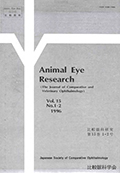Volume 15, Issue 1-2
Displaying 1-9 of 9 articles from this issue
- |<
- <
- 1
- >
- >|
Facilities in the field of Comparative Ophthalmology
-
1996Volume 15Issue 1-2 Pages 1-2_1-1-2_4
Published: 1996
Released on J-STAGE: December 25, 2020
Download PDF (1056K)
Special Lecture at 15th Symposium
-
1996Volume 15Issue 1-2 Pages 1-2_5-1-2_11
Published: 1996
Released on J-STAGE: December 25, 2020
Download PDF (2457K)
Original Report
-
1996Volume 15Issue 1-2 Pages 1-2_13-1-2_25
Published: 1996
Released on J-STAGE: December 25, 2020
Download PDF (5678K)
Brief Note
-
1996Volume 15Issue 1-2 Pages 1-2_27-1-2_30
Published: 1996
Released on J-STAGE: December 25, 2020
Download PDF (882K)
Reports at 15th Symposium on Some Problems in the Field of Comparative Ophthalmology
-
1996Volume 15Issue 1-2 Pages 1-2_31-1-2_37
Published: 1996
Released on J-STAGE: December 25, 2020
Download PDF (2282K) -
1996Volume 15Issue 1-2 Pages 1-2_39-1-2_43
Published: 1996
Released on J-STAGE: December 25, 2020
Download PDF (1443K) -
1996Volume 15Issue 1-2 Pages 1-2_45-1-2_48
Published: 1996
Released on J-STAGE: December 25, 2020
Download PDF (948K) -
1996Volume 15Issue 1-2 Pages 1-2_49-1-2_58
Published: 1996
Released on J-STAGE: December 25, 2020
Download PDF (2851K)
Information & Data
-
1996Volume 15Issue 1-2 Pages 1-2_59-1-2_61
Published: 1996
Released on J-STAGE: December 25, 2020
Download PDF (805K)
- |<
- <
- 1
- >
- >|
